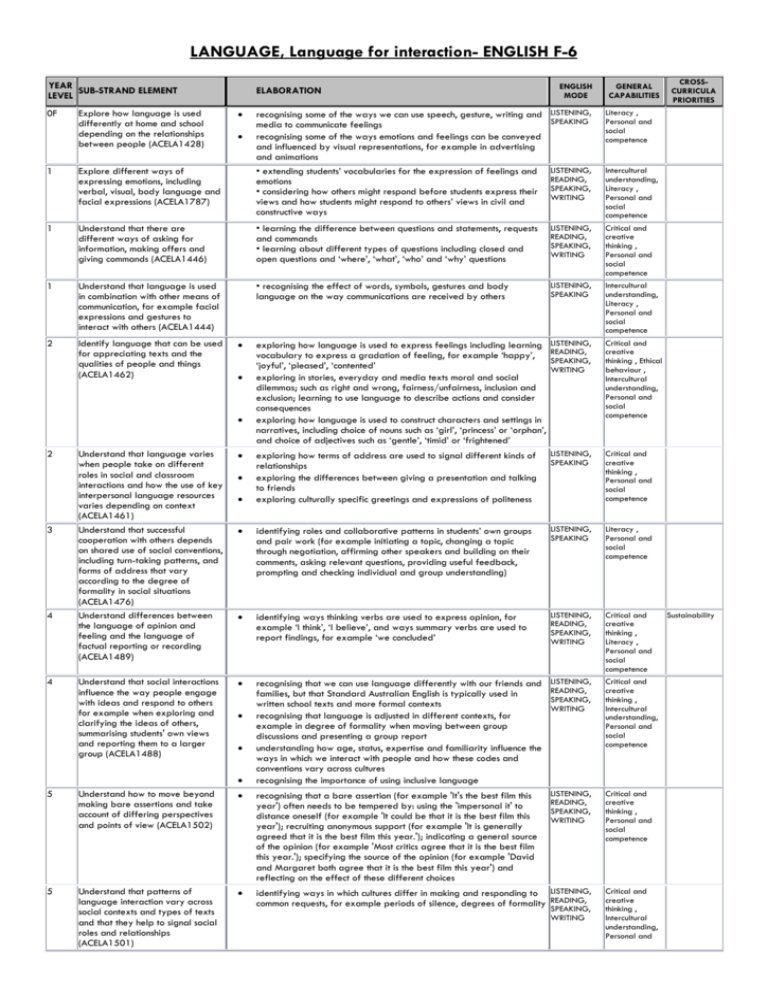LANGUAGE, Language for interaction- ENGLISH F
advertisement

LANGUAGE, Language for interaction- ENGLISH F-6 YEAR SUB-STRAND ELEMENT LEVEL 0F Explore how language is used differently at home and school depending on the relationships between people (ACELA1428) ELABORATION ENGLISH MODE GENERAL CAPABILITIES recognising some of the ways we can use speech, gesture, writing and media to communicate feelings recognising some of the ways emotions and feelings can be conveyed and influenced by visual representations, for example in advertising and animations • extending students’ vocabularies for the expression of feelings and emotions • considering how others might respond before students express their views and how students might respond to others’ views in civil and constructive ways LISTENING, SPEAKING Literacy , Personal and social competence LISTENING, READING, SPEAKING, WRITING Intercultural understanding, Literacy , Personal and social competence 1 Explore different ways of expressing emotions, including verbal, visual, body language and facial expressions (ACELA1787) 1 Understand that there are different ways of asking for information, making offers and giving commands (ACELA1446) • learning the difference between questions and statements, requests and commands • learning about different types of questions including closed and open questions and ‘where’, ‘what’, ‘who’ and ‘why’ questions LISTENING, READING, SPEAKING, WRITING Critical and creative thinking , Personal and social competence 1 Understand that language is used in combination with other means of communication, for example facial expressions and gestures to interact with others (ACELA1444) • recognising the effect of words, symbols, gestures and body language on the way communications are received by others LISTENING, SPEAKING Intercultural understanding, Literacy , Personal and social competence 2 Identify language that can be used for appreciating texts and the qualities of people and things (ACELA1462) exploring how language is used to express feelings including learning vocabulary to express a gradation of feeling, for example ‘happy’, ‘joyful’, ‘pleased’, ‘contented’ exploring in stories, everyday and media texts moral and social dilemmas; such as right and wrong, fairness/unfairness, inclusion and exclusion; learning to use language to describe actions and consider consequences exploring how language is used to construct characters and settings in narratives, including choice of nouns such as ‘girl’, ‘princess’ or ‘orphan’, and choice of adjectives such as ‘gentle’, ‘timid’ or ‘frightened’ LISTENING, READING, SPEAKING, WRITING Critical and creative thinking , Ethical behaviour , Intercultural understanding, Personal and social competence exploring how terms of address are used to signal different kinds of relationships exploring the differences between giving a presentation and talking to friends exploring culturally specific greetings and expressions of politeness LISTENING, SPEAKING Critical and creative thinking , Personal and social competence identifying roles and collaborative patterns in students’ own groups and pair work (for example initiating a topic, changing a topic through negotiation, affirming other speakers and building on their comments, asking relevant questions, providing useful feedback, prompting and checking individual and group understanding) LISTENING, SPEAKING Literacy , Personal and social competence 2 3 4 4 Understand that language varies when people take on different roles in social and classroom interactions and how the use of key interpersonal language resources varies depending on context (ACELA1461) Understand that successful cooperation with others depends on shared use of social conventions, including turn-taking patterns, and forms of address that vary according to the degree of formality in social situations (ACELA1476) Understand differences between the language of opinion and feeling and the language of factual reporting or recording (ACELA1489) identifying ways thinking verbs are used to express opinion, for example ‘I think’, ‘I believe’, and ways summary verbs are used to report findings, for example ‘we concluded’ LISTENING, READING, SPEAKING, WRITING Critical and creative thinking , Literacy , Personal and social competence Understand that social interactions influence the way people engage with ideas and respond to others for example when exploring and clarifying the ideas of others, summarising students' own views and reporting them to a larger group (ACELA1488) recognising that we can use language differently with our friends and families, but that Standard Australian English is typically used in written school texts and more formal contexts recognising that language is adjusted in different contexts, for example in degree of formality when moving between group discussions and presenting a group report understanding how age, status, expertise and familiarity influence the ways in which we interact with people and how these codes and conventions vary across cultures recognising the importance of using inclusive language LISTENING, READING, SPEAKING, WRITING Critical and creative thinking , Intercultural understanding, Personal and social competence LISTENING, READING, SPEAKING, WRITING Critical and creative thinking , Personal and social competence 5 Understand how to move beyond making bare assertions and take account of differing perspectives and points of view (ACELA1502) recognising that a bare assertion (for example 'It's the best film this year') often needs to be tempered by: using the 'impersonal it' to distance oneself (for example 'It could be that it is the best film this year'); recruiting anonymous support (for example 'It is generally agreed that it is the best film this year.'); indicating a general source of the opinion (for example 'Most critics agree that it is the best film this year.'); specifying the source of the opinion (for example 'David and Margaret both agree that it is the best film this year') and reflecting on the effect of these different choices 5 Understand that patterns of language interaction vary across social contexts and types of texts and that they help to signal social roles and relationships (ACELA1501) identifying ways in which cultures differ in making and responding to LISTENING, common requests, for example periods of silence, degrees of formality READING, SPEAKING, WRITING Critical and creative thinking , Intercultural understanding, Personal and CROSSCURRICULA PRIORITIES Sustainability YEAR SUB-STRAND ELEMENT LEVEL ELABORATION ENGLISH MODE GENERAL CAPABILITIES social competence 6 Understand the uses of objective and subjective language and bias (ACELA1517) 6 Understand that strategies for interaction become more complex and demanding as levels of formality and social distance increase (ACELA1516) understanding when it is appropriate to share feelings and opinions (for example in a personal recount) and when it is appropriate to remain more objective (for example in a factual recount) differentiating between reporting the facts (for example in a news story) and providing a commentary (for example in an editorial) LISTENING, READING, SPEAKING, WRITING Critical and creative thinking , Literacy , Personal and social competence identify and appreciate differences in language used in diverse family settings LISTENING, SPEAKING Critical and creative thinking , Literacy , Personal and social competence CROSSCURRICULA PRIORITIES





